
 |
|
Under The Tuscan Sun (2003) Cast: Diane Lane, Sandra Oh, Lindsay Duncan, Raoul Bova, Vincent Riotta, Pawel Szadja, Giulia Steigerwalt, Roberto Nobile, Mario Monicelli, Anita Zagaria, Evelina Gori, Valentine Pelka, Sasa Vulicevic, Massimo Sarchielli, David Sutcliffe, Elden Henson, Dan Bucatinsky 2003 – 110 minutes Rated: Reviewed by Dustin Putman, September 27, 2003. 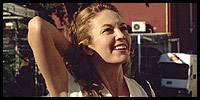 "Under the Tuscan Sun" evokes the power of an exquisite landscape whose visual poeticism speaks louder than words every could—and for good reason. Loosely based on the best-selling travelogue memoir of the same name by Frances Mayes, the film has been jazzed up with a more cohesive narrative and conventional characters but its meatiest strength remains the often unforgettable images. Some of them are predictably of the Italian scenery, but others involve the incendiary framing of characters and inanimate objects. In fact, "Under the Tuscan Sun" is so very beautiful and idyllic it's a shame its plotting doesn't hold such close scrutiny.
"Under the Tuscan Sun" evokes the power of an exquisite landscape whose visual poeticism speaks louder than words every could—and for good reason. Loosely based on the best-selling travelogue memoir of the same name by Frances Mayes, the film has been jazzed up with a more cohesive narrative and conventional characters but its meatiest strength remains the often unforgettable images. Some of them are predictably of the Italian scenery, but others involve the incendiary framing of characters and inanimate objects. In fact, "Under the Tuscan Sun" is so very beautiful and idyllic it's a shame its plotting doesn't hold such close scrutiny.
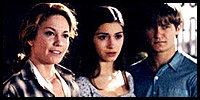 Frances Mayes (Diane Lane) is a 35-year-old San Francisco writer and book critic whose life is put into a tailspin when she discovers her husband has been having an affair. In an effort to help her get over the painful divorce, best friend Patti (Sandra Oh) gives her a ticket for a bus trip through Italy—something Frances cannot refuse. What Frances does not expect is that, on an impulse, she will end up purchasing a Tuscan home and not returning to the U.S. As she works on fixing the property up, Frances takes a spiritual journey that leaves her reconsidering love, in the form of the suave Marcello (Raoul Bova), and forming valuable relationships she otherwise would never have had.
Frances Mayes (Diane Lane) is a 35-year-old San Francisco writer and book critic whose life is put into a tailspin when she discovers her husband has been having an affair. In an effort to help her get over the painful divorce, best friend Patti (Sandra Oh) gives her a ticket for a bus trip through Italy—something Frances cannot refuse. What Frances does not expect is that, on an impulse, she will end up purchasing a Tuscan home and not returning to the U.S. As she works on fixing the property up, Frances takes a spiritual journey that leaves her reconsidering love, in the form of the suave Marcello (Raoul Bova), and forming valuable relationships she otherwise would never have had.
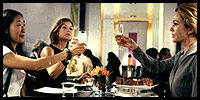 Written and directed by Audrey Wells, "Under the Tuscan Sun" has a low-wattage plot that, in lesser hands, might have turned into a cheesy Lifetime movie where Judith Light melodramatically picks her life back up after she finds her lover cheating on her. While this premise is intact, the film elegantly takes the high road, avoiding maudlin emotions and developments at almost every turn in favor of something more simple and naturalistic. In developing a book that had very little of a basic storyline, however, Wells has trouble in giving the proceedings a definitive backbone that demands viewer interest. After all, the centerpiece of the action involves little more than a house being repaired.
Written and directed by Audrey Wells, "Under the Tuscan Sun" has a low-wattage plot that, in lesser hands, might have turned into a cheesy Lifetime movie where Judith Light melodramatically picks her life back up after she finds her lover cheating on her. While this premise is intact, the film elegantly takes the high road, avoiding maudlin emotions and developments at almost every turn in favor of something more simple and naturalistic. In developing a book that had very little of a basic storyline, however, Wells has trouble in giving the proceedings a definitive backbone that demands viewer interest. After all, the centerpiece of the action involves little more than a house being repaired.
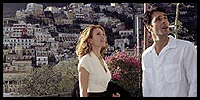 Thank goodness, then, for the perfectly tuned performances and cinematography by Geoffrey Simpson (2000's "Center Stage"). The Tuscan countryside is breathtakingly rendered, its flower fields and silky valleys bathed in a heavenly golden sunlight. Other shots are not only ambitious, but lyrical, recalling the stupendous work of Federico Fellini. One moment, directly reminiscent of 1960's "La Dolce Vita," places aging, free-spirited actress Katherine (Lindsay Duncan) in a fountain, trampling around in the water and invigorated by the freedom to do so. It is an exquisite scene in every respect. Simpler but no less memorable images include a water faucet on the wall that never seems to work, and a single tear that falls from Patti's eye as she lays in bed and unloads her soul.
Thank goodness, then, for the perfectly tuned performances and cinematography by Geoffrey Simpson (2000's "Center Stage"). The Tuscan countryside is breathtakingly rendered, its flower fields and silky valleys bathed in a heavenly golden sunlight. Other shots are not only ambitious, but lyrical, recalling the stupendous work of Federico Fellini. One moment, directly reminiscent of 1960's "La Dolce Vita," places aging, free-spirited actress Katherine (Lindsay Duncan) in a fountain, trampling around in the water and invigorated by the freedom to do so. It is an exquisite scene in every respect. Simpler but no less memorable images include a water faucet on the wall that never seems to work, and a single tear that falls from Patti's eye as she lays in bed and unloads her soul.
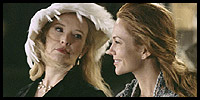 Fresh off her Oscar nomination for 2002's "Unfaithful," Diane Lane understands Frances and seriously digs underneath this woman's skin, grit and all. When Frances' world suddenly changes, she has no idea how to accept it and move on. At the same time, she is horrified of her seemingly irrational decision to move to Tuscany. Lane brings equal parts fear, warmth, desperation, and joy to a plum part and makes it completely her own. Of note in supporting parts are the underrated Sandra Oh (2002's "Big Fat Liar"), brilliant in 1998's "Last Night" and getting some sterling moments here, who gives her Patti a sureheadedness offset by an unexpected vulnerability; and Lindsay Duncan (1999's "An Ideal Husband"), an unforced scene-stealer as the warmhearted Katherine, a wealthy actress who has more wisdom to offer Frances than could ever meet the eye.
Fresh off her Oscar nomination for 2002's "Unfaithful," Diane Lane understands Frances and seriously digs underneath this woman's skin, grit and all. When Frances' world suddenly changes, she has no idea how to accept it and move on. At the same time, she is horrified of her seemingly irrational decision to move to Tuscany. Lane brings equal parts fear, warmth, desperation, and joy to a plum part and makes it completely her own. Of note in supporting parts are the underrated Sandra Oh (2002's "Big Fat Liar"), brilliant in 1998's "Last Night" and getting some sterling moments here, who gives her Patti a sureheadedness offset by an unexpected vulnerability; and Lindsay Duncan (1999's "An Ideal Husband"), an unforced scene-stealer as the warmhearted Katherine, a wealthy actress who has more wisdom to offer Frances than could ever meet the eye.
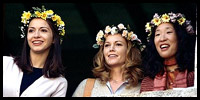 At its base, "Under the Tuscan Sun" is admirable for avoiding treacly plot points and, save for a run-in with an out-of-control thunderstorm, shoots for realism within its every situation. Likewise, the acting is superlative. The film has the ability to be purely beautiful, but it approaches this feat only in spurts rather than consistently. Without a constant forward motion in its plotting, the film lacks urgency. "Under the Tuscan Sun" is a first-class travelogue of sights and scenes; its whole, ultimately, is less than the sum of its parts.
At its base, "Under the Tuscan Sun" is admirable for avoiding treacly plot points and, save for a run-in with an out-of-control thunderstorm, shoots for realism within its every situation. Likewise, the acting is superlative. The film has the ability to be purely beautiful, but it approaches this feat only in spurts rather than consistently. Without a constant forward motion in its plotting, the film lacks urgency. "Under the Tuscan Sun" is a first-class travelogue of sights and scenes; its whole, ultimately, is less than the sum of its parts.
|
© 2003 by Dustin Putman |














